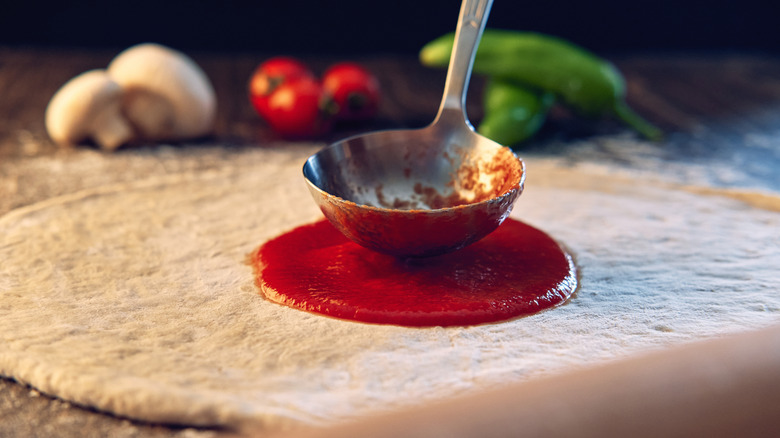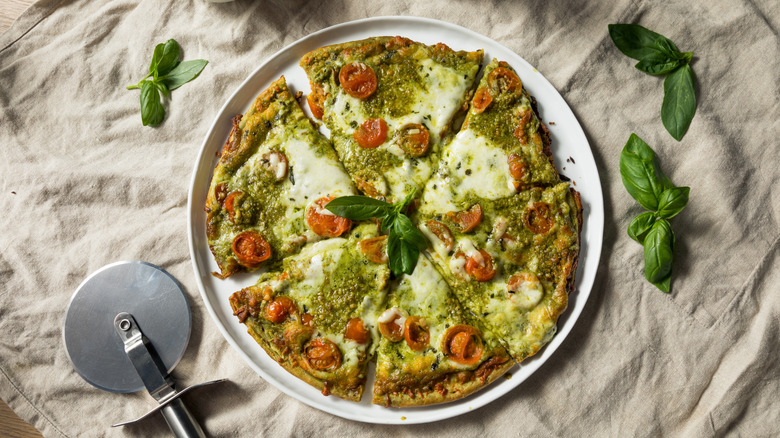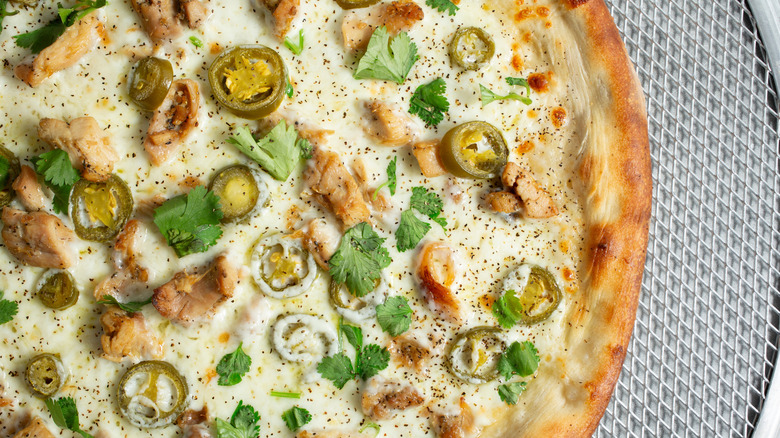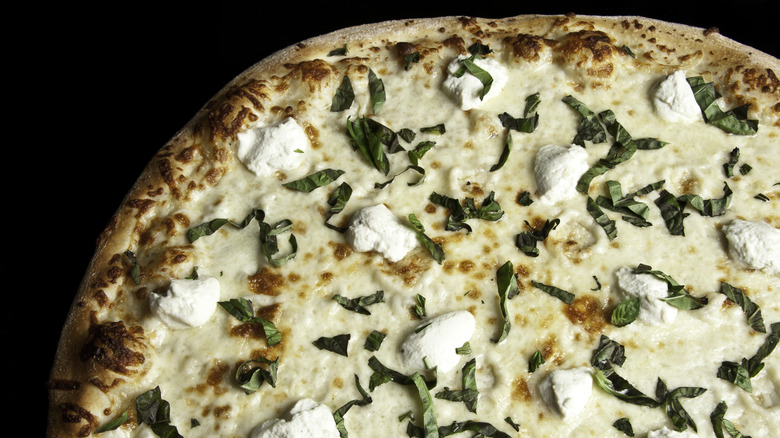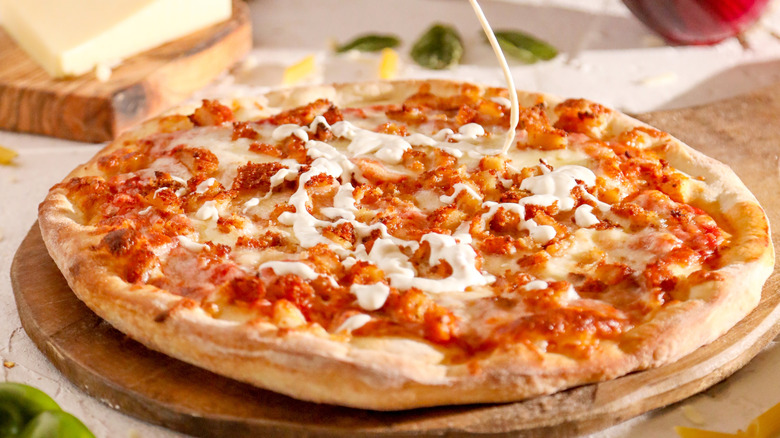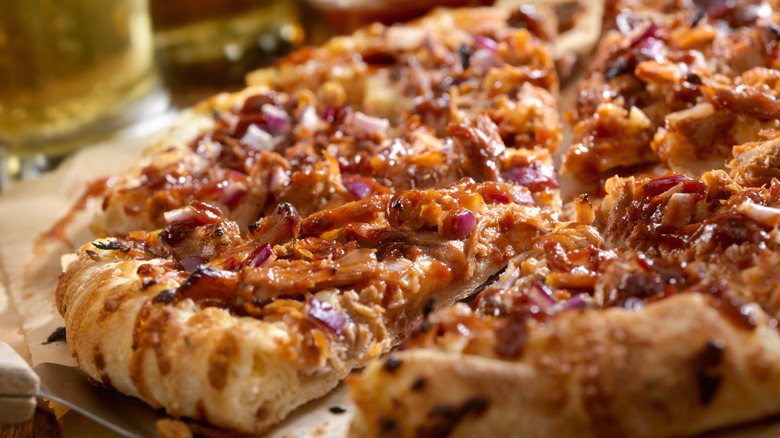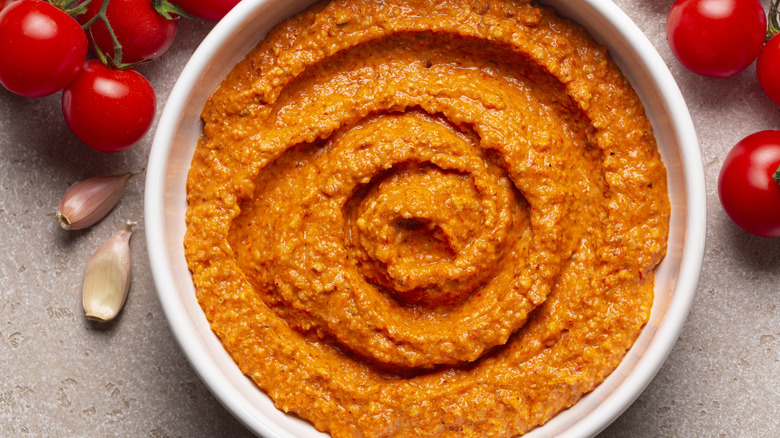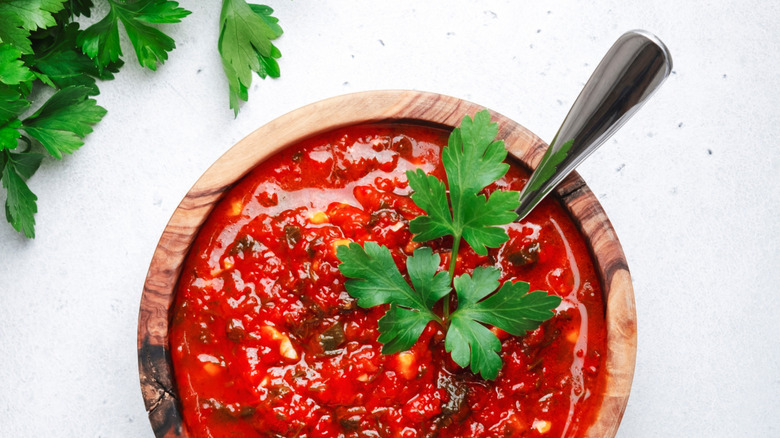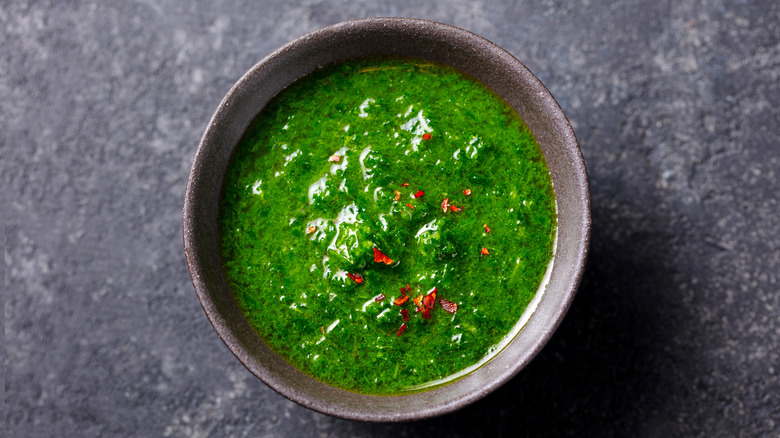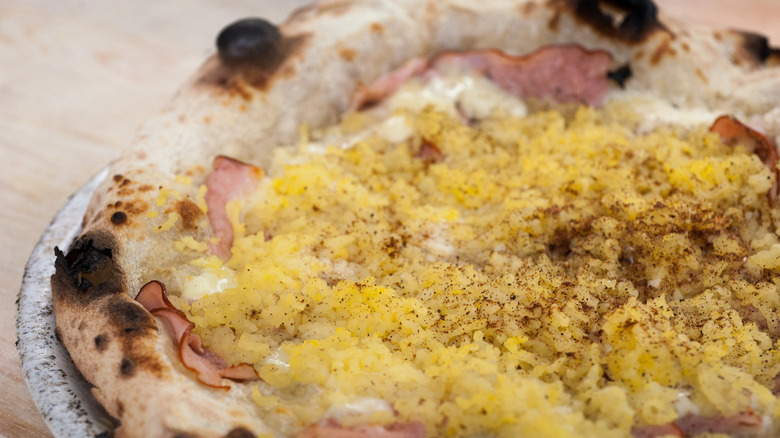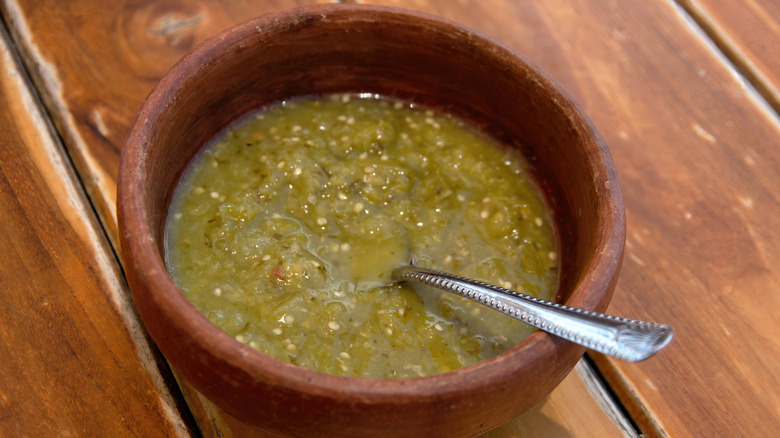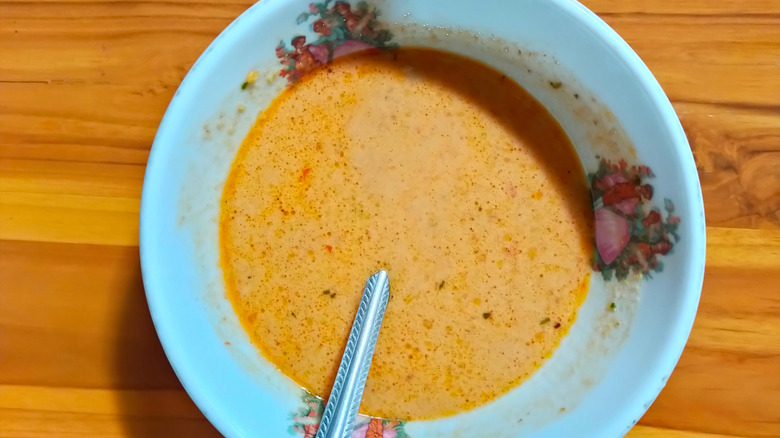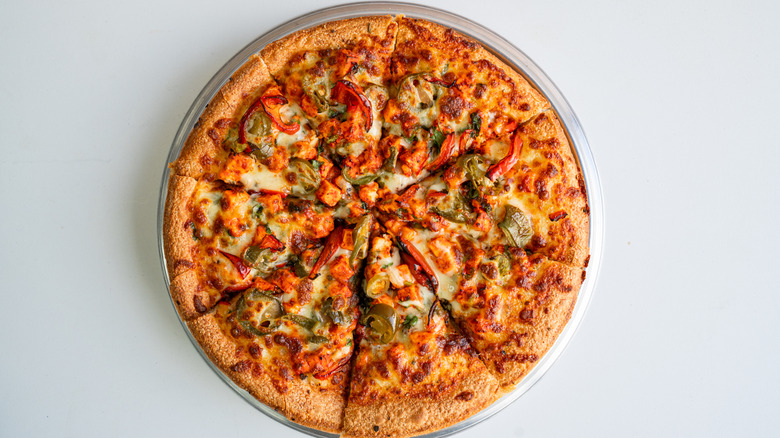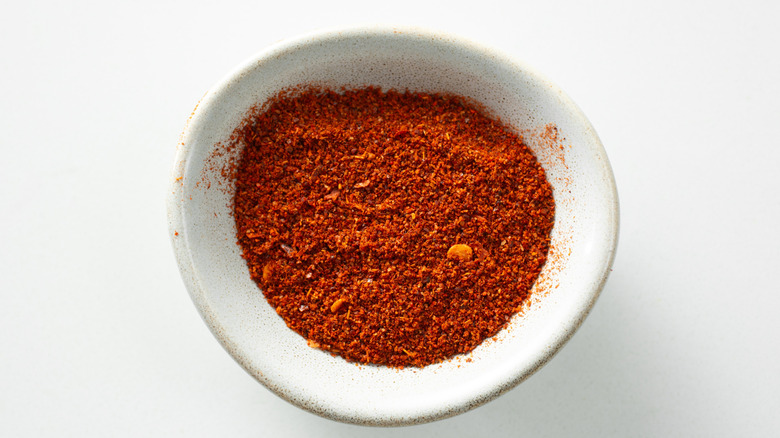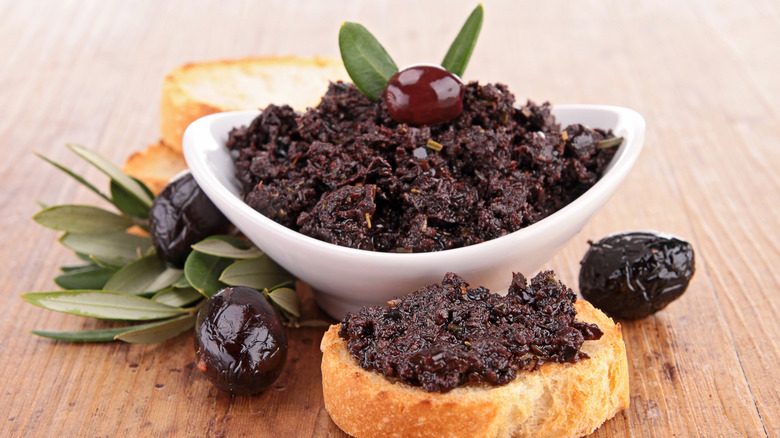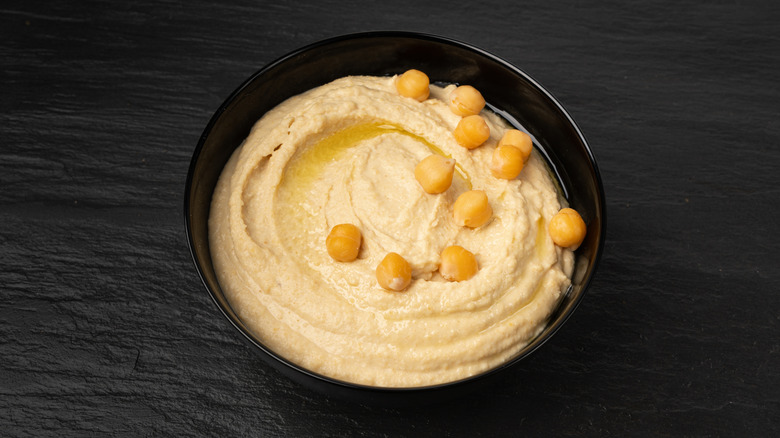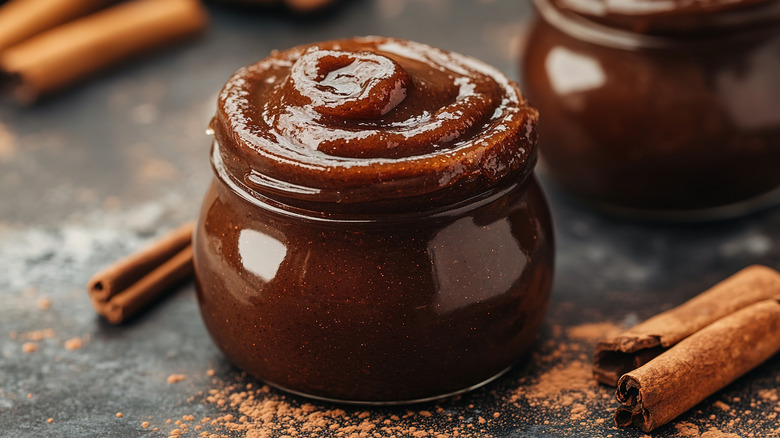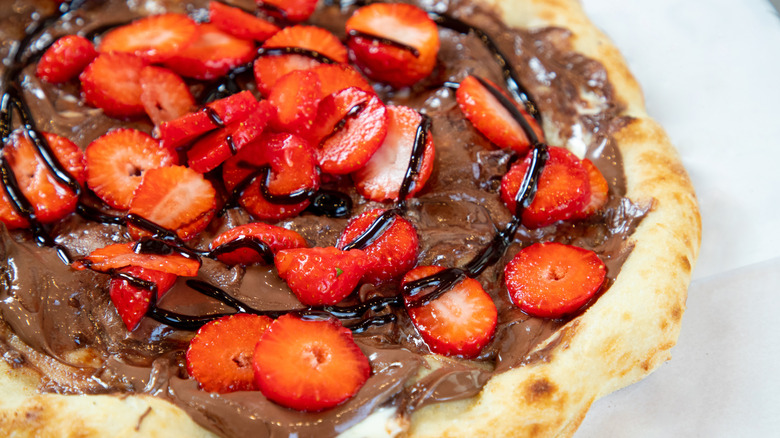17 Best Sauces To Use On Pizza, Besides Tomato
Everyone has their perfect version of pizza. Up until my early adulthood, mine was a standard, New Haven-style pie with mozzarella. Cheese, sauce, crust — nothing more, nothing less. It wasn't until I started working in a pizzeria, and eventually crafting my own pizzas at home, that I realized that there was a whole world of creative, ingenious, and out-there pies worth exploring.
I found that the easiest way to gradually introduce myself to these pies was to experiment more with the sauce. Traditional tomato pizza sauce does its job, sure, but it isn't the best. You can easily swap out your ho-hum tomato sauce with something more flavorful, punchy, and complex, yet still have the safety net of your favorite toppings, cheese, and crust style of choice. Here are some of the best and most flavorful sauces you can and should add to homemade pizza.
Pesto
Pesto is one of my favorite sauces as a whole. Not only is it a tasty topping for a hot plate of bucatini or gemelli, but it also makes for a tremendous pizza sauce. Everyone's recipe for pesto is different, but the foundation includes fresh basil, olive oil, garlic, and Parmesan. It's incredibly aromatic and flavorful, yet also is simple enough to allow the toppings to shine. Plus, it infuses your pizza with a subtle herby flavor without having to add herbs to the top — which may or may not burn.
You can check out the best store-bought pesto sauce or whip up your own. I personally like using a homemade version for pizza because I can cut the basil with spinach — making it cheaper and helping to tamper down its flavor a little more. Try pairing a pesto pizza with fresh sliced mozzarella, sun-dried tomatoes, roasted bell peppers, and/or artichokes.
Alfredo
Jarred Alfredo sauce isn't something to write home about, at least when it's mixed into a pasta. While you can add a protein kick with sliced chicken or shrimp, it can be hard to disguise its bland flavor. But, when you spoon a little on top of your pizza, you will reap all of its rich, creamy, and cheesy flavor in every single bite.
I will say that Alfredo is a very rich and heavy sauce, so you'll need to be mindful about how much of it you add to your crust. Spoon too much on and you risk weighing down your palate and also making the crust too moist. A thinner layer is better, especially if you're working with toppings that don't have strong flavors. I like pairing Alfredo with complementary flavors that I would find in a pasta dish. A few pieces of shrimp, topped with fresh arugula and Parmesan, makes a simple, seafood-forward pie. You can also use the rich sauce to quell spicy toppings, like Fresno chiles or jalapeños.
Garlic and olive oil
If you order a "white" pie at a pizzeria, chances are that you'll be served something with an olive oil "sauce." This sauce is typically the base for a cheese-forward pie — like four-cheese. However, it can also be a lighter option for when you're working with heavy toppings, like on a loaded veggie pizza. If you combined a wet tomato sauce with toppings that release a ton of steam as they bake, the pizza might not crisp up in the oven — putting you at risk for a soggy pie.
You don't need to saturate your crust with olive oil; a light swirl should suffice. I like to use a one-two punch of olive oil and garlic to give it a little more flavor, but you can opt for a plain oil crust if you want to keep things simple. That being said, olive oil is far from the most flavorful sauce on this list to try, so try to pair it with toppings that warrant its basic flavor — like flavorful cheeses and meats.
Buffalo
Buffalo sauce is a favorite for wings, but it turns out that it also makes a great pizza sauce. You don't need a ton of it to impart a spicy, buttery flavor to your pie — and you won't have to risk a soggy pie. While adding it to the top of your pizza after it has exited the oven is always an option, baking the sauce on the pie will develop its flavors even more, seeing as how it'll meld with the cheese and toppings.
Naturally, Buffalo chicken is always an option — and one that can be made better with the addition of bacon, candied jalapeños, and a ranch dressing dip. Though, one of my favorite plant-based pies is a riff on my old pizzeria's "Leeky Chicken." It pairs chopped leeks, Buffalo cauliflower, and garlic for a flavorful pie. You can use a variety of bases for it, including Buffalo sauce, olive oil, Alfredo, or béchamel.
Barbecue
Barbecue sauce is an incredibly versatile ingredient that everyone should keep in your pantry. Not only can it dress up a variety of meats, like pork and chicken, but it can also be used to elevate mac and cheese or meatloaf, too.
If you're after a slightly sweeter pizza, try swapping classic tomato pizza sauce for barbecue sauce. As the sauce bakes, the sugars will concentrate and caramelize, offering a delectable flavor that can complement an array of toppings. It would be a tasty base for a pulled pork or jackfruit pizza, topped with bacon, red or caramelized onions, and a drizzle of hot honey (if you like things super sweet).
One of the best things about barbecue sauce pizzas is that you can always tweak the sauce to fit your flavor profile. For example, if you like the tomatoey taste of a regular pizza sauce, try adding in extra tomato paste or ketchup. Or, if you like things hot, opt for a squirt of chili oil or cayenne.
Romesco
Romesco is an interesting and unique sauce. If you don't frequently dive into Spanish food, it may not be on your radar — until now of course. This flavorful sauce consists of roasted tomatoes and peppers (which give it a similar umami profile to a classic tomato sauce), almonds or hazelnuts, garlic, and olive oil. It's smoky, complex, and bright, making it a great addition to a pizza.
Traditionally, romesco sauce is made into a paste. So, you may have to add a little more oil to get it to a spreadable consistency. Since its flavor is so well-rounded and complex, you're better off pairing it with simple toppings, like thinly-sliced potatoes, red onions, artichokes, and Parmesan. You can also make your pizza extra creamy by dolloping ricotta on the top, which will also help balance out some of the heat from the romesco. This versatile, flavorful, and complex sauce is a great one to try if you're looking for a pizza sauce that has a little more character than a red sauce, but don't want to leave out the tomatoes entirely.
Arrabbiata
If you like your pasta sauce hot, you are probably well-acquainted with arrabbiata. This sauce literally translates from Italian as "angry" — and its fiery burn certainly embodies that name in its entirety. The burn comes from the inclusion of dried chili pepper flakes — other than that, the sauce is very similar to a classic tomato sauce.
You can give your pizza sauce a spicy arrabbiata twist by adding some hot pepper flakes to it. While you can use a store-bought arrabbiata pasta sauce recipe, keep in mind that there's a difference between pasta sauce and pizza sauce. If your pasta sauce is watery, you may risk making your pizza crust too soggy. And, you won't get the same potent tomato flavor that you would get from pizza sauce. As such, I would recommend just adding your chili flakes into the pizza sauce. Top your arrabbiata-sauced pie with ricotta, fresh mozzarella, roasted veggies, and 'nduja — if you can stand a little more spice.
Chimichurri
Chimichurri is a sauce typically reserved for grilled meats, but it turns out that its bright flavors make it a great alternative to both pesto and regular ol' tomato sauce. While the exact recipe for chimichurri varies, it often contains parsley, oregano, garlic, olive oil, vinegar, and chili flakes, mixed together with a pestle and mortar. Parsley and oregano are no stranger to Italian fare, so it's easy to see how chimichurri could be a great vessel for adding flavor to your pizza.
One recipe worth trying is an Argentine-inspired chimichurri and tomato pizza, which includes toppings like mozzarella, provolone, cherry tomatoes, and red pepper flakes. This vegetarian-friendly pie would be great served on a hot summer night alongside a tasty green salad. You could also add steak to the top of your chimichurri pizza to play off this classic combination, though anything with that same charred flavor (think roasted onions, tomatoes, and peppers) would also be fair game.
Béchamel
Wait, didn't we already cover a cream-based sauce? While Alfredo and béchamel have a lot in common, they are not the same thing. The latter is one of the French mother sauces, prepared by combining a roux of flour and butter together with milk. There's no cheese involved.
Béchamel would be a better fit for a pizza where you want the cheese on top to do the talking, rather focus on the cheese in the sauce. Aside from the common addition of ground nutmeg, béchamel doesn't really have a flavor besides "milky." As such, you can pair it with complex and flavorful toppings whose flavor would otherwise be lost in a tomato or an Alfredo sauce. One example would be a scallop pizza, which would be excellent with crumbled bacon and a sprinkle of lemon zest post-bake. You could also go with a shrimp pizza here, and add on some arugula after it comes out of the oven for extra crunch and a complementary bitter note that cuts through the richness of the sauce.
Salsa verde
So remember how I said no tomatoes ... well, salsa verde is technically fair game, seeing as how it gets its bright flavor from tomatillos rather than tomatoes. It also incorporates some flavorful and fragrant aromatics, like garlic, lime juice, white onion, and cilantro. It's the perfect, Mexican-inspired condiment that your pizza needs.
Since this sauce is rooted in Mexican fare, it seems logical that you would want to pair it with ingredients from a similar region. A sprinkle of Cotija cheese, shredded chicken, and fire-roasted veggies are all excellent additions to a salsa verde-sauced pie. The freshness and acidity of the sauce also opens up tons of avenues to experiment with especially hot ingredients, like jalapeños and pickled Fresno chiles. I would recommend staying away from richer meats, as you don't want to dull any of the beautiful tang and depth of the sauce. But I could see why you'd want to add a sprinkle of crumbled chorizo to your pie.
Peanut sauce
Peanut sauce is a must-have for dipping chicken satay into, but it turns out that this versatile sauce is an excellent addition to pizza as well. The spice level will vary based on who's making it, but it tends to incorporate a standard roster of ingredients like peanut butter, soy sauce, rice wine vinegar, garlic, and ginger. Peanut sauce boasts a great interplay between the nutty and fatty peanut sauce, tangy vinegar, salty soy sauce, and aromatic garlic and ginger. However, like many of the sauces on this list, it's best used in small doses and needs to be paired thoughtfully with toppings in order to work.
Since peanut butter sauce is most commonly used for Asian-inspired recipes, that would be the route I would recommend going when it comes to topping it. Shredded chicken, plain mozzarella, and chopped onions are a great place to start, as they would allow the peanut sauce's flavor to take center stage. You could also dress this up by adding toppings to it after it comes out of the oven, like shredded carrots, slivered cucumbers, and pickled veggies for a fresh crunch.
Curry sauce
There's nothing like a warm bowl of curry, brimming with complex spicy notes. You can easily transfer this flavor to your pizza by whipping up a simple, yet tantalizing, curry sauce for it. Since "curry" is open up to interpretation, there are no right or wrong ways to make this pizza sauce. If you like a tomatoey curry that's reminiscent of classic pizza sauce, consider adding a little bit of tomato sauce to your base. Or, if you like things on the hotter side, use a spicier curry blend instead of a sweet one. Regardless of how you season and flavor your curry sauce, you're going to want to make sure it's thick and easy to spread rather than thin and watery. You could even use a jarred curry sauce — which tends to be thicker than a homemade base — for your pizza.
Once your curry sauce is prepared, spread it on your pie and top it with things like veggies, thinly-sliced potatoes, and the proteins you would find floating around in curry, like chicken or shrimp. You could even use naan instead of dough for a unique and Indian-inspired twist on classic pizza.
Harissa
Harissa is a unique North African spice blend that every home cook should add to their arsenal. It includes caraway seeds, coriander, cumin, chiles, and garlic, though its exact recipe will vary. Harissa can be made into a paste with olive oil and lemon juice; these two ingredients are integral for complementing the spiciness of the sauce and making it spreadable.
Harissa is often used to season meats, but it's also good for adding bold, smoky flavor to roasted veggies. As such, you can use it for vegetarian and meat lover's pizzas alike. It's especially tasty when paired with ingredients that share its geographic provenance; think olives, tomatoes, fresh herbs, and onions.
Olive tapenade
I will admit something right off the bat: I'm not a fan of olives in the slightest. Thinking about tapenade makes me want to gag, but I can see the appeal of adding it to a pizza or a flatbread. Olives are briny and salty, which makes them a welcomed flavor on a pizza. Plus, they also have umami notes, and depending on what you add to your recipe, you may also get tanginess, too.
An olive tapenade pizza would be a great match for cheese and vegetables, seeing as how olives are a popular ingredient in Mediterranean cuisine. Try it on a pizza with shredded mozzarella, feta, sun-dried tomatoes, and onions. I won't blame you if you pop an anchovy or two on top, too.
Hummus
Hummus and pizza usually don't mix — unless you run out of crackers and need something to scoop up the rest of your dip with. But if you want to give your pizza a protein boost, it's a worthy substitute for pizza sauce.
Hummus is incredibly versatile; not only can you stick to a basic recipe with chickpeas, oil, lemon juice, and garlic, but you can also add your own herbs, veggies, and more to make it uniquely your own. I should note, though, that when hummus is cooked, it tends to take on a dry consistency that may not be approachable to all eaters. But, if you cover your hummus pizza in veggies, cheese, and the like, you should have no problem enjoying it. Try some chopped red onions, garlic, spinach, and shredded mozzarella on your hummus pizza. The subtle bean-y flavor is the perfect complement to these assertive toppings.
Apple butter
Apple butter is one of my favorite things to make with a surplus of apples. All you need to do is add your fruit to a slow cooker and let it simmer down with spices and sugar until it's thick and jammy.
Many people's minds might go straight to a dessert pizza, but apple butter is truly a pizza sauce replacement that can go either sweet or savory. It works great with cheese, particularly sharp cheddar, as well as anything in the oaky and maple-y flavor family, like bacon, maple syrup, or hot honey. I would also recommend looking at savory ingredients that you might find on a charcuterie board, like Gorgonzola, candied pecans, and a sprinkle of arugula for sharpness. Apple butter is an incredibly versatile pizza sauce, and it's one that's worth trying if you love the interplay between sweet and savory in every bite.
Nutella
Don't worry, I'm not going to suggest that you should pair your Nutella-topped pizza with shredded mozzarella. Nutella is a great one for kid-friendly dessert pizzas because it spreads so easily and will impart a sublime chocolatey, nutty flavor.
The unique thing you'll want to do for a Nutella pizza that you don't do for other sauces on this list is to bake the pizza crust first, then add your Nutella to the top after it has cooled slightly. Anyone who has spread this sweet sauce on a slice of toast knows that it can get very runny very fast, so baking your pizza crust ahead of time will ensure that the base doesn't get soggy. You should also prick the crust with a fork before sliding it into the oven, seeing as the base won't have any toppings to weigh it down as it bakes.
Since you're not baking your toppings on this pizza, you can opt for fresh fruits, candies, and the like. Sliced strawberries, apples, and bananas are a great place to start, while crumbled Ferrero Rocher candies will tie into that hazelnut essence well.
